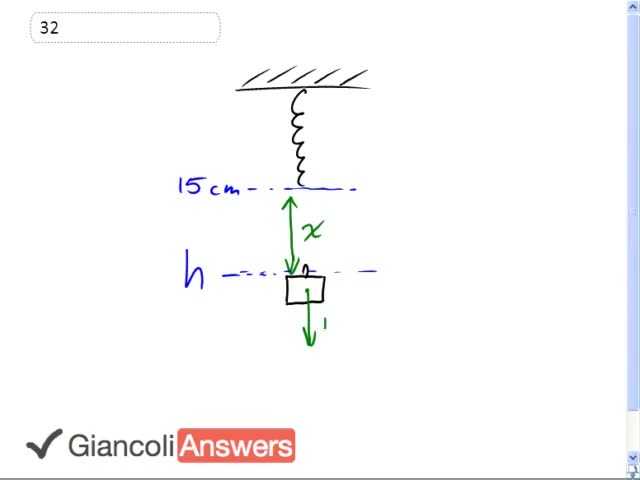

In order to watch this solution you need to have a subscription.
This block hanging on a spring will be hanging at a position where the gravity going down which is 'mg' equals the force of the spring going up. So here's the spring force, that equals k times x which is the amount the spring is stretched. So 'x' is the stretch of the spring and 'h' is the reading on the ruler at that position. So 'h' is going to be the answer to that question. 'X' is what we are going to use though in our equations. We have that the force of gravity down equals the spring force going up. We are doing this with 92 tiers so let's ignore negative signs. We'll solve for this 'x' dividing both sides by 'k'. And we get that 'x' is 'mg' over 'k' and substituting in numbers we get 2½ kilograms times 9.8 Newton’s per kilogram divided by 53 Newton’s per meter is 'x' as 0.462 length in meters so our answer to this question 'h' is going to be the 15 centimeters that the spring starts at plus this stretch of 46.2 centimeters and that will give us the 2 sig figs ANSWER centimeters.
Now you may have tried answering this question by saying the change in the potential energy of the block which is 'mg' times it's the amount that it descended from, where it was put on to the spring so it's. Descended at a distance 'x' that equals the increase in the potential energy of the spring and this does not work. NO way. And the reason why is kind of subtle. I'll give it a bit of explanation here if you want to hear the whole story just put a comment under this video and I'll make a video just about this point.
What's going on is, the question doesn’t say it but there is a presumed invisible hand holding onto this mass. As it's going down, you know if you were to put the mass onto the spring up here and then let it fall so the invisible hand. There needs to be this invisible hand in order to make the net force zero. See this block supposedly doesn’t accelerate. But the spring can't provide enough force to prevent acceleration in fact at this position the spring provides no force because it isn’t stretched yet. And then as it goes down the spring force gradually is increasing, But gravity is never the less, more than it. Gravity is more than the spring force at all positions until it gets to here. So there's this invisible hand needed to compensate for the springs inability to match the gravity. And well maybe this is a weird way of saying it but yeah this invisible hand is here because the speed has to be constant throughout this drop. If you were to actually put this weight on to the spring, what would in fact happen in the real world is that the weight would go down to this position and then beyond. Because it would be accelerating through this whole distance here and at this point when the spring force equals the gravity force it will stop accelerating and it would go further still. And until it gets to a point where it's decelerating now throughout this distance here. Acceleration is upwards because beyond this point the spring force is greater than gravity. And then finally it will stop at a position down here. So what you're missing in this expression, what's missing in this expression is the fact that it's going to have some kinetic energy as well as potential energy.
So in the real case without some goofy invisible hand in the real case, the weight will be put on top it will accelerate to this point. It will have lost some potential energy equal to 'mgx' certainly and it will have gained some potential energy due to the spring. That's correct but additionally it will have some kinetic energy and this is what's missing in this expression.
Can you post a video of how to find the total distance the block would fall if there wasn't an invisible hand.